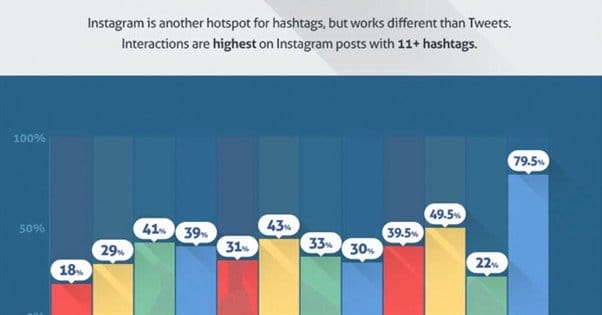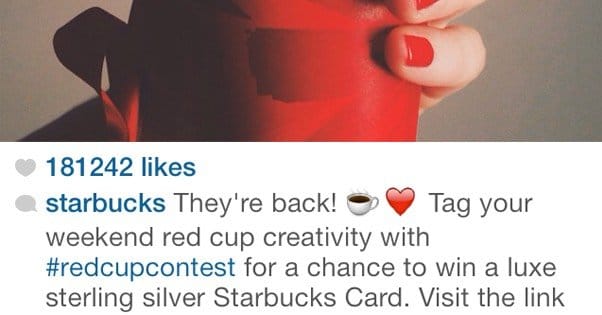 Written by ContentPowered.com
Written by ContentPowered.com
Hashtags were a Twitter invention, more or less. They spread to other places around the web from there. Tumblr uses them in expanded form for post categorization and sub-commentary. Instagram uses them much as Twitter does. Facebook uses them poorly. People use them in places they aren’t even valid, just as a joke.
Yes, I know Facebook owns Instagram. However, their use of hashtags could not be more different. On Facebook, they’re shunned and tend to actually lower engagement rates. On Instagram, they form the basis of one of the most explosive growth strategies available.
So, yes, use hashtags on Instagram. In fact, use all of them. Instagram allows you to post up to 30 hashtags in the description of each image. Some people feel this looks spammy, and sure, it kind of does. The thing is, the “hashtag block” at the bottom of descriptions on Instagram is kind of like meta data at this point. Most users basically ignore it, so it’s only relevant for making an image show up in the hashtag category when a user browses that tag.
Studies have been performed on how using hashtags affects engagement on Instagram photos. Many people summarize it and think 11 hashtags is the ideal number, but in reality, 11 is the ideal minimum. I, and some others, wholeheartedly recommend coming up with 30 good hashtags you can use in your descriptions.
If you’re worried about spam, there’s a way you can hide your hashtags as well. You can add them after your description, and after five lines of periods. You can see an example in this image:
Honestly, though, I don’t even think you need to go this far. People don’t really pay much attention to the hashtag spam.
If you’re using 30 hashtags in your images, it means you need to have a good selection of tags. Picking the right tags is 75% of the battle, here.
You have 30 slots per image for tags. I would say that there are three categories of tags you want to make sure are covered in these 30. Let’s go over them.
Category 1: Branded tags. These are tags that you create that are relevant to your brand. For example, Macy’s having a winter sale might use #MacysWinter. These tags are not in common use, because they’re branded; people don’t generally search for branded tags unless they already know the tag exists.
The reason you create and use branded hashtags is so that you can track activity outside of your own feed. You can monitor them to see when other people mention those tags, so you can see what kind of activity your advertising is stirring up. Generally, I would say you only need to use 1-2 branded hashtags per post on Instagram. One should be a branded tag relevant to your specific campaign, like the Macy’s Winter one above. One of them should be a general branded tag, like #Macys. If you want more, you can have variants on your specific campaign tags.
The exception to only using 1-2 tags is if you’re running some kind of contest, where you need a contest-specific tag for users to use to enter the contest. This kind of tag is something you monitor to track entries and to pick a winner.
Category 2: Image-specific tags. These are tags that are generic, that is, not branded. In the Macy’s winter sale example, it might be something like #WinterSale. They’re also relevant to the specific image that you’re posting. If you’re posting a picture of snowy rail lines to indicate a feeling of calm wintery weather, you might use tags like #Cold or #Train. There’s a lot of variety here; anything that’s part of the image can be covered in an image-specific tag.
In addition to these sorts of descriptive tags, you can also include tags about meta-information as well. Some photography buffs might want to include the type of camera used to take the photo, if it was taken with anything special. You might also include what filter you used on Instagram, or simply #NoFilter for the inclusion, though that’s an extremely active tag, so it has drawbacks. More on that later.
Category 3: Industry-relevant tags. These are tags that relate less to the image and more to your business. Macy’s winter sale might use #Clothing here, or #Fashion. They’re tags that represent who you are as a brand and a business, without being branded. This allows people who are fans of your industry to find you even if they don’t follow your brand itself.
Industry-relevant tags might sound familiar to you once you start digging into them, and there’s a good reason for that. There’s a lot of overlap between them and your keyword research. The only difference is that with keyword research you’re hunting for the long tail to find unique keywords with low competition. With hashtags, you’re looking for less long-tail keywords that would have more competition, because on Instagram, competition equals traffic. The more traffic a keyword has, the more people have the chance to view your image, within limits. Again, more on that later.
So how many of each should you use, specifically? Well, it will vary. In general, I would say about 3-5 should be branded tags, though you can get away with just one for tracking purposes. Of the remaining, oh, 27, 7-12 should be image-specific. This gives people who are interested in certain individual topics a good chance to see the image. The remaining 15-20 should be your industry-relevant tags. This makes sure the people in your industry will see the images as well.
For each image, your industry-relevant tags will not change too much. Neither will your branded tags. Therefore, it is the image-specific tags that get the most leeway to change from image to image.
There’s also a fourth category of hashtags that you may use, but they don’t apply to everyone. These are the local tags. Online-only businesses and global brands don’t really get to take advantage of local hashtags, because they don’t have a strong local identity. If you have a local focus on your image or on your brand, you can use geographic tags such as your location or the location where the photo was taken as additional identifiers.
What Makes a Good Hashtag?
So now you know the kinds of hashtags you need and about how many of each you should have, but how do you know if a hashtag is worthwhile or not? There are a bunch of different criteria you can use to filter out tags that just won’t work.
Hashtags should be relevant to your niche. If you’re a brand selling shoes, and you post a picture of winter boots being used, you can’t post your photo using #books or #basketball and reasonably expect to be considered anything other than spam. It’s the same thing as years and years ago, when people would shoehorn in hundreds of keywords onto their webpages to attempt to rank for Google searches that had little to do with their actual topic. The problem with this approach is that people want to see images related to #basketball and they see your boots-in-snow picture, it’s irrelevant. They don’t want to see it, they aren’t going to click it, they aren’t going to follow you for posting it, so you get nothing out of it. Always make sure your tags are relevant.
Hashtags should be active. Always check a tag before you use it and see when the last post was made and how many posts are made in a given time frame. Now, what’s considered “active” will vary. For branded tags, it doesn’t matter at all. They’re for your use, not for the public. For image and industry tags, you want to find tags that have posts and comments with some degree of frequency. Some tags might only get five or six posts per day, and that’s pretty slow. Some might only get one post per week, and that indicates that they’re not very active.
You can’t use tags with no activity, because if no one uses them, no one is going to see your image through them. It’s not really hurting you to use them, except that one of your 30 slots is going to a tag that isn’t benefitting you.
Hashtags shouldn’t be too active. The most popular tags, like #cute and #nofilter, have the problem of having too much traffic. Rather than having an audience of millions seeing your posts, you really only have the subsection of those millions that are actually browsing at that specific time. Once the post falls a few hundred down the list, no one is scrolling far enough back to see it, so it might as well not exist. I recommend no more than 2-3 of these highly active tags per image.
You can also target hashtags that your competitors are using. Take a look at the Instagram feeds of your biggest competitors and look at their most recent dozen or so posts. Check out the kinds of hashtags they’re using on their content. If you’re in an average, intelligent industry, you’ll see a lot of good keywords you can target. If you’re in an unenlightened industry, you might see few or no hashtags, or just some bad tag choices, which is both good and bad. It’s bad because you can’t steal ideas, but it’s good because you’ll be able to easily outperform your competition if they continue to fail to use good hashtags.
Just make sure not to accidentally try to use competitor branded hashtags. Macy’s advertising for Kohls might not work out too well for Macy’s.
Keep in mind that you can actually use more than 30 tags, you just have to post some of them in comments after the image. These additional tags will still sort your image into the feed for those tags chronologically when the image was posted, though. This means you need to use the most popular tags in your description, and can save less popular tags like geographic identifiers and branded tags for use in comments. If you try to add your image to a popular tag later, it won’t show up near the top, and so might as well be invisible.
It’s entirely possible to use more than 30 hashtags, but it’s a technique that is likely to have diminishing returns. For one thing, it means you need to come up with more than 30, even 60, 90, or more. At that point, you’re likely to have a lot of nearly duplicate hashtags. There are two problems with this. The first is that there’s likely to be a lot of crossover in the audiences browsing them. The second is that they’re not all going to be highly active; some of them will be clearly dominant, while others are more like secondary long-tail hashtags.
If you do manage to find more than 30 that you want to use, keep in mind one thing. The filing of where your image shows up in the hashtag feed depends on the timestamp of the image, not of the hashtag. Adding an image to a hashtag later will not bring it to the top of the feed, like it used to ages ago. Therefore, you want to sort your hashtags. All of the most popular, more active hashtags should be kept to the top and posted in the description of the image, when the image itself is posted.
The 31+ group of tags, the less relevant and less active tags, should go in a comment. You can post them in a comment straight up, or you can attempt to hide them. You can use the five periods method if you wish, and if so, your comment will simply appear as a […] in the Instagram comment feed. This is a link so people can click and expand to see the comment, but they don’t have to, and many won’t. Should you? That’s up to you.






